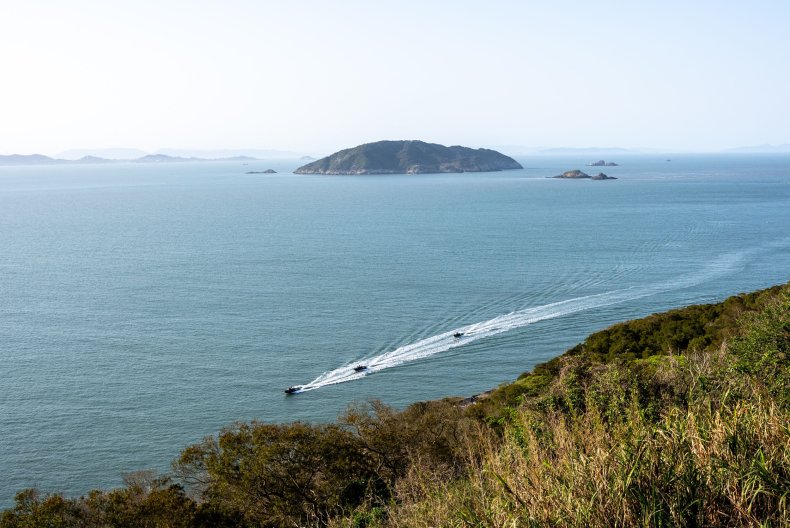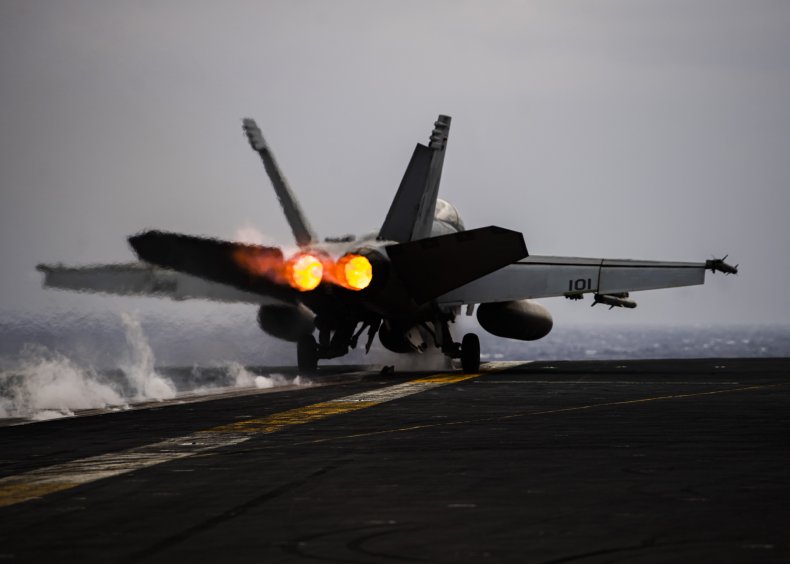U.S. Navy Strike Group Keeps Close Eye on China's Carrier Near Taiwan
Chinese and American carrier groups were both on maneuvers in relative proximity in the Western Pacific on Monday as China concluded a three-day show of force around Taiwan.
The Shandong, the second of China's three aircraft carriers, embarked on its first-ever deployment to the Pacific on April 5, hours before a meeting on United States soil between House Speaker Kevin McCarthy and President Tsai Ing-wen of Taiwan. The warship and its escorts took part in "encirclement" exercises around the island as part of Beijing's response, the Chinese military said.
China claims Taiwan as its own and has pledged to seize it by force if necessary. Its government considers Tsai a separatist for seeking to perpetuate the long-standing status quo across the Taiwan Strait, which has seen the island remain de facto independent since 1949 when Communist Party leaders took power in Beijing.
Tsai convened national security officials on Saturday as China began the drills that included bomber and fighter aircraft sorties and mock missile strikes against "key targets" in Taiwan and in its surrounding waters. The Chinese military said it "successfully completed" exercise "Joint Sword" with a simulated blockade of the island and precision strikes.

The war games involved less direct firepower than the dayslong quasi-blockade and live-fire exercise that followed Nancy Pelosi's visit to Taipei last August, when she became the first sitting House speaker in 25 years to visit the island.
But there was no shortage of military pressure as dozens of Chinese warplanes, accompanied by 8-11 warships, operated in Taiwan's nearby sea and airspace.
This included at least four sorties by J-15 fast jets, which flew into the island's southeastern air defense identification zone—a self-declared buffer over international airspace—for the first time on Monday, according to the Taiwanese defense ministry. The carrier-based aircraft were launched from the Shandong, which was operating roughly 200 nautical miles east of the island as part of the squeeze from all sides.
But the Shandong was being closely watched by America and treaty ally Japan. The Joint Staff of Japan's Self-Defense Force, which watched the Shandong enter the Western Pacific last week, said the Chinese carrier launched 80 aircraft and 40 helicopter sorties between April 7-9 while on maneuvers 125-230 nautical miles south of the Japanese island of Miyako.
Escorting the Shandong were Chinese destroyer Jiaozuo, frigates Xuchang and Liuzhou as well as combat support ship Chaganhu, Tokyo's information showed.
Also in the area, about 320 nautical miles east of Taiwan, was the USS Nimitz, the flagship of the U.S. Navy's Carrier Strike Group 11, whose naval exercise with Japanese warships took the allies from the East China Sea into the Western Pacific by the weekend, according to announcements by both sides.
Asked about the Nimitz's presence last week, Taiwan defense chief Chiu Kuo-cheng said: "We can't say it has come for [the Shandong], but its position, its posture, is related."

The Hawaii-based U.S. Indo-Pacific Command did not respond to an email from Newsweek seeking comment about the deployment.
After China launched war games in response to Pelosi's visit to Taiwan last year, the U.S. kept its military assets away from the island so as not to give Beijing another pretext to further escalation tensions. "We will not be reflexive or knee-jerk; we will be patient and effective," Kurt Campbell, the White House's Indo-Pacific coordinator, said in August.
Su Tzu-yun, a director and research fellow at Taiwan's top military think tank, the Institute for National Defense and Security Research, said the U.S. decision to keep the Nimitz nearby reflected Washington's belief that "no matter what Taiwan or the U.S. does, China is set on the path of expansion."
"The Nimitz is a very special case," he told Newsweek. "It's showing off its capability while keeping the Taiwan Strait in range of its fighter aircraft."
Unlike the Chinese military drills that followed Pelosi's trip to Taiwan, the recent exercise involved more "political-military signaling," Su said. Having already secured a third term as China's paramount leader, Xi Jinping could afford to scale down his response to avoid any diplomatic backlash or disruption to his country's economy.
Wang Wenbin, a spokesperson for the Chinese foreign ministry, said Monday that the drills were "a stern warning to the provocative activities of 'Taiwan independence' separatist forces and their collusion with external forces." Taiwan's independence is "irreconcilable" with cross-strait peace and stability, Wang said.
Taiwan's foreign ministry urged China to "be rational and exercise self-control." It added: "Stop coercing the Taiwanese people and changing the status quo in the Taiwan Strait."
"As a responsible member of the international community, Taiwan will not escalate conflict or provoke disputes," its statement said. "Taiwan will firmly defend its sovereignty and national security, and hold the defensive line of democracy and freedom."
Beijing spun up its latest show of force as a delegation from the House Foreign Affairs Committee was visiting Taiwan. Representative Michael McCaul of Texas, the committee's Republican chair, told Fox News on Friday that the option of defending the island with U.S. troops was "on the table" if the American public supported the action.
Republican Senator Lindsey Graham of South Carolina, who visited Taipei one year ago this month, told Shannon Bream of Fox News Sunday that Beijing was "setting the stage, possibly, for a blockade of Taiwan." He urged more training for Taiwanese troops and more U.S. forces in Asia.
"Listen, I believe in a one-China policy, but I would be willing to fight for Taiwan because Taiwan is a democracy; we've stood with them for decades," he said. "Strategic ambiguity is not working."
Asked whether he would support a U.S. defense of Taiwan, Graham said: "The question for the Congress: should we have a defense agreement with the island of Taiwan? We don't. Should we have one? But yes, I'd be very much open to using U.S. forces to defend Taiwan because it's in our national security interest to do so."
Do you have a tip on a world news story that Newsweek should be covering? Do you have a question about China or Taiwan? Let us know via worldnews@newsweek.com.








